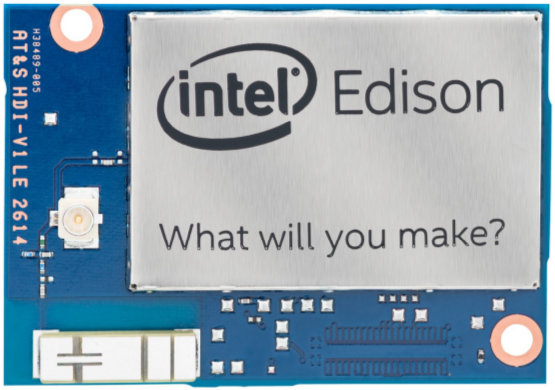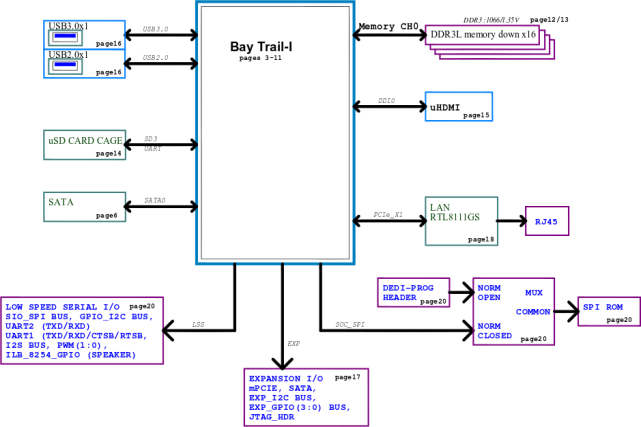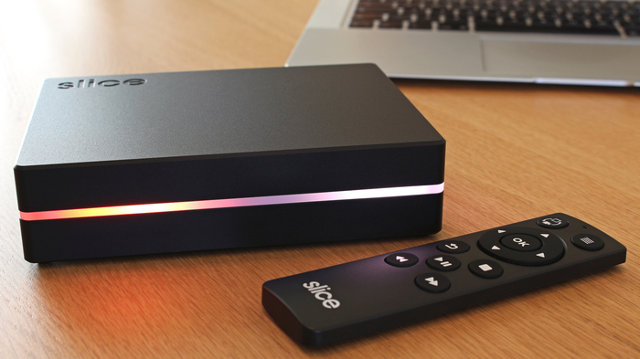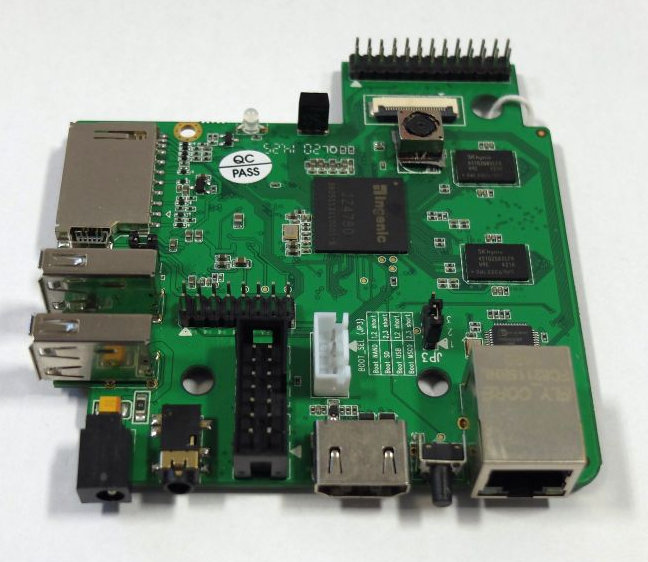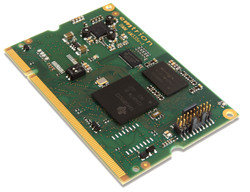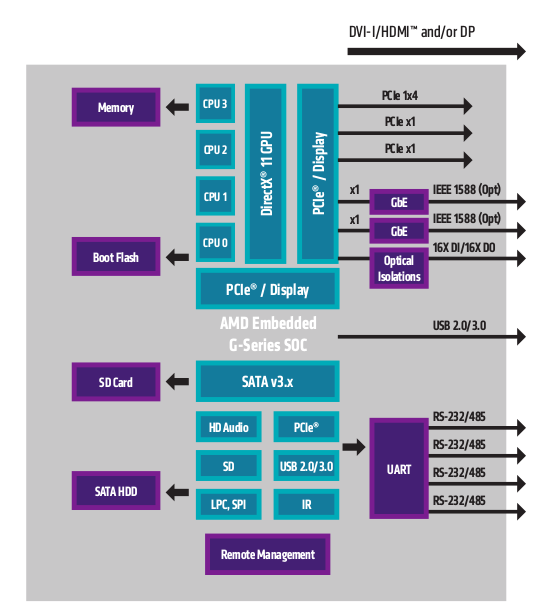Intel announced the Edison board for wearables applications last January at CES 2014. When it first came out, it looked like an SD card, but the board look has now drastically changed. Nevertheless, the important point is that Intel Edison is now available, together with various development kits, and runs Linux (Yocto built), as well as an RTOS. With the official release, we’ve also got the full specifications: SoC – Dual-core, dual-threaded Intel Atom (Silvermont) processor (22nm) processor @ 500 MHz and a 32-bit Intel Quark micro-controller @ 100 MHz. Includes 1GB LPDDR3 PoP memory System Memory – 1 GB LPDDR3 (PoP memory) – 2 channel 32bits @ 800MT/sec Storage – 4 GB eMMC (v4.51 spec) + micro SD card connector Connectivity – Dual band 802.11 a/b/g/n Wi-Fi (Broadcom 43340) with either an on-board antenna or external antenna, and Bluetooth 4.0 USB – 1x micro USB connector I/Os: 2x UART […]
MinnowBoard MAX Schematics, Board layout, Gerber, and BoM Released
MinnowBoard MAX (aka MinnowBoard2) is an embedded board powered by Intel Atom Bay-Trail-I E3815 (single core) or E3825 (dual core) processor, with 1 to 2GB RAM, SATA II, USB 3.0, Gigabit Ethernet ports, and more. The board currently officially supports four operating systems: Debian GNU/Linux, Linux built with the Yocto Project, Android 4.4, and Windows 8.1. One of its main selling point is the price as the single core version sells for $99, and the dual core version for $129, rivalling in price with equivalent ARM based development boards. It’s also an open source hardware board, and as it’s now about to ship, CircuitCo released all hardware files under a Creative Commons CC-BY-SA license, allowing anybody with the right skills to create a clone, or their own hardware. Here are the files that have been released: Schematic (PDF) Schematic (Orcad DSN) Board Layout (Allegro BRD) Gerbers Bill of Materials Schematics […]
Embedded Linux Conference Europe 2014 Schedule – IoT, ARM vs x86, Optimization, Power Management, Debugging…
The Embedded Linux Conference Europe (ELC 2014), CloudOpen, and LinuxCon Europe will jointly take place at the Congress Centre Düsseldorf, in Germany on October 13 – 15, 2014. The 3-day events will consists of keynotes, presentations, and tutorials. Each day will open with two or three keynotes by speakers including Jim Zemlin (Executive Director, Linux Foundation), and Jono Bacon (XPRIZE), followed by presentation and tutorials. There will be 45 presentations for ELCE, 58 for LinuxCon, and 47 for CloudOpen, I’ll make a virtual schedule with a few sessions part of the Embedded Linux Conference Europe “track”. Monday, October 13 11:15 – 12:05 – Performance Analysis Using the Perf Suite by Mans Rullgar, Consultant When faced with a performance problem, the initial steps towards a solution include identifying the sections of code responsible and the precise reasons they are time-consuming. To this end, the ‘perf’ profiling tools provide valuable insight into the […]
Raspberry Pi Based Slice, and EzeeCube Quad Media Players Support Internal Hard Drives (Crowdfunding)
Slice is a media player based on Raspberry Pi Compute Module, and EzeeCube Quad is media hub powered by Freescale i.MX6 Quad, and an upgrade to EzeeCube based on i.MX6 dual, which was successfully funded. The underlying hardware between Slice and EzeeCube is much different, but both devices have a lot in common. They are both media players currently being crowd-funded respectively in Kickstarter and Indiegogo, both comes with an internal hard drive, run XBMC, targets typical end-users (rather than tinkerers) and are somewhat pricey. Slice Media Player When I first saw Slice, all I could see was an Raspberry Pi module, put in a case with an internal hard drive bay, and lots of pretty RGB LEDs, and with an air mouse sold for an inflated price of 114 GBP ($190 US) without hard drive or 179 GBP ($300 US) with a 1TB drive, with admittedly some cheaper early […]
MIPS Creator CI20 Development Board Powered by Ingenic JZ4780 SoC
There are plenty of ARM based development boards running Linux and Android, but with MIPS it’s a different story. Microchip does have some affordable development board powered by their MIPS MCUs, but these don’t have the hardware specs to run Linux based operating systems, and Ingenic Newton Platform for wearables can run Android and Linux, but it appears to be reversed to companies with virtual no documentation. There are some MIPS platform running OpenWRT on hardware such as routers or Wi-Fi boards, but these can’t be considered fully supported development boards. But Imagination Technologies is trying to make MIPS more relevant, first by launching Prpl developers’ community, and MIPS Creator CI20 development board powered by Ingenic JZ4780 dual core MIPS32 (Xburst) core processor with PowerVR SGX540 GPU should soon be available with complete documentation and source code. Let’s go through the hardware specifications first: SoC – Ingenic JZ4780 dual core […]
Intel Announces Galileo Gen 2 Development Board Based on Quark SoC
As many of us are waiting for our Intel Galileo board promised by Microsoft, and right after the Raspberry Pi foundation announced the Raspberry Pi Model B+, Intel has introduced a new version of the Galileo board which they simply call Galileo Gen 2. The development board is still powered by Intel Quark single core SoC (Pentium class) and with the same key features as the original Galileo Board, but with some tweaks based on the feedback from the community. Intel Galileo Gen 2 specifications (Changes in Bold): SoC- Intel Quark SoC X1000 single core, single-thread application processor @ 400 MHz, with 12KB embedded SRAM System Memory – 256MB DDR3, 5 Storage – 8MB NOR fklash, 8KB EEPROM, and micro SD card slot (up to 32GB) Connectivity – 10/100M Ethernet USB – 1x USB 2.0 host port, 1x micro USB 2.0 device port used for programming Debugging / Programming 10-pin […]
Emtrion DIMM-AM335x SoM Supports Mainline Linux Kernel
When I cover system-on-modules (SoM), companies will usually provide some BSP (Board Support Packages) for older kernels, and did not submit their changes to mailine kernel, so I was interested in a news from Emtrion entitled “DIMM-AM335x: Linux mainline support ready“, which actually means they’ve done the work to support a recent Linux kernel (3.14) and provides instructions and code (device tree files), but did not submit patches to the linux-arm-kernel mailing list to get their changes added to kernel.org. Let’s look at the hardware specs first: SoC – Texas Instruments Sitara AM335x ARM Cortex A8 processor @ 720Mhz to 1GHz (AM3354 or AM3359) System Memory – onboard 512 MB SDRAM/optional 256 MB Storage – 512 MB NAND Flash (managed) + 2 SD card interfaces Display – LCDs I/F with resolution up to SVGA, with 4-wire touch interface Audio – Analog Audio with SSI I/F USB – USB 2.0 Host […]
AMD Introduces Embedded G-Series “Steppe Eagle” SoCs and “Crowned Eagle” CPUs
AMD has added six new members to is Embedded G-Series family with “Steppe Eagle” SoCs comprising a CPU, GPU and I/O in a single chip, and “Crowned Eagle” CPUs that are not actually CPUs in the old sense, but SoCs comprised of a CPU and I/O chipset, and all of them also include AMD’s ARM based PSP (Platform Security Processor) built upon ARM TrustZone architecture. You may also remember AMD G-Series APUs which are comprised of a CPU and GPU, and connected to an external I/O chipset, but none of these were announced today. The six new AMD G-Series processors are as follows: “Steppe Eagle” SoCs: GX-424CC – Quad core @ 2.4 GHz with 2MB L2 cache, and a GPU @ 497MHz. DDR3-1866 support. TDP: 25W GX-412HC – Quad core @ 1.2 GHz with 2MB L2 cache, ad a GPU @ 300MHz. DDR3-1333 support. TDP: 7W GX-212JC – Dual core @ 1.2 GHz […]


